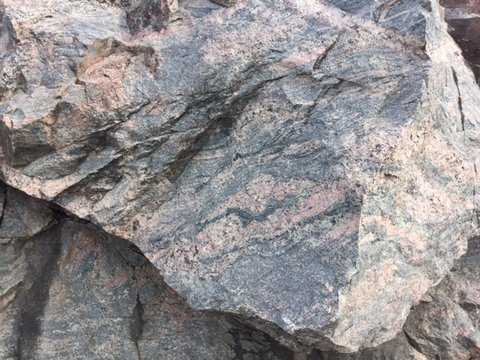A Bit of Minnesota in Michigan: Morton Gneiss
Morton gneiss (pronounced “nice”) is popularly mined in the Minnesota town of Morton. Geologists estimate that this metamorphic rock is about 3.5 billion years old. This type of rock originally started as magma. Magma slowly cooled below the surface of present-day southwestern Minnesota, forming gray granite. About a billion years after this process occurred, the granite was subjected to immense heat and pressure, which caused the grey granite to merge with a layer of pink granite, forming Morton gneiss. Morton gneiss is a type of metamorphic rock; some specimens occasionally contain pink and grey bands that are a lasting reminder of the metamorphic process. Roughly 12,000 years ago, much of the American Midwest was covered with glaciers (the Wisconsin glaciation). When these glaciers retreated into Canada, they carved out lakes and prominent rivers, like the Minnesota River. After years of fluvial erosion, the Minnesota River carved out a valley, exposing much of the Morton gneiss observed today in the region. Morton gneiss colloquially goes by “rainbow gneiss,” as it can come in various colors. Here are some minerals and corresponding colors commonly found in this type of gneiss:
Quartz → white color
Feldspar → gray or pink color
Biotite → black or dark brown color
Amphibole → dark green color

Foliated vs. Non-foliated Rock:
Foliated metamorphic rocks are layered. This reflects the direction that pressure was applied to the rock when it was metamorphosed. The mineral grains align, creating a plate/layer-like appearance. Schist and slate are common types.
Non-foliated rocks occur due to heat and pressure being applied in many directions. A sheet-like appearance does not occur as minerals are not explicitly arranged.

Logging Tasks:
- Observe the piece of gneiss underneath the green park sign. Describe the appearance of the rock.
- Note the color variations present. What colors and corresponding minerals are present in this specimen of Morton gneiss?
- Is this specimen of gneiss foliated or non-foliated?
- If they are present, measure the average width of the layers/bands in the rock.
- As of June 2019, earthcaches now contain required photo logging tasks. Please provide a photo of yourself, your GPSr, or a personal item that proves that you have visited this site. Please post this in your log.
Sources:
https://www.mnopedia.org/thing/morton-gneiss
https://geology.com/rocks/metamorphic-rocks.shtml
https://www.thinglink.com/scene/763069412788928512
| We have earned GSA's highest level: |
 |


